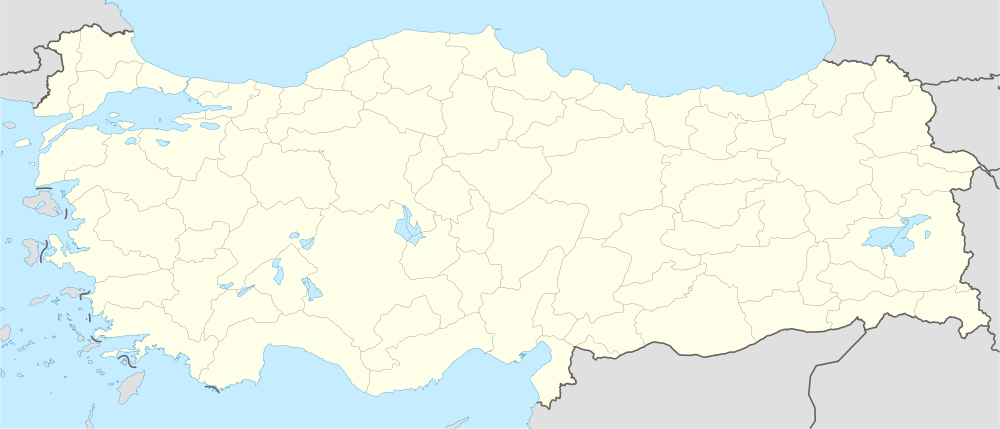Enez
| Enez | |
|---|---|
 Enez | |
| Coordinates: 40°44′00″N 26°04′00″E / 40.73333°N 26.06667°ECoordinates: 40°44′00″N 26°04′00″E / 40.73333°N 26.06667°E | |
| Country | Turkey |
| Province | Edirne |
| Government | |
| • Mayor | Ahmet Çayır (DSP) |
| • Kaymakam | Fatih Baysal |
| Area[1] | |
| • District | 438.18 km2 (169.18 sq mi) |
| Population (2012)[2] | |
| • Urban | 3,723 |
| • District | 10,516 |
| • District density | 24/km2 (62/sq mi) |
| Website |
www |
Enez is a town and a district of Edirne Province, in Thrace, Turkey. The pre-Turkish name of the town was Aenus (Greek: Αἶνος).
The mayor is Ahmet Çayır (DSP). The population is 3,826 as of 2010.
Location
The town is located on the left (eastern) bank of the river Hebrus, where its estuary broadens to flow into the Gulf of Saros, the ancient Melas Gulf, and so into the Aegean Sea. Enez occupies a ridge of rock surrounded by broad marshes. In ancient Greek times, it lay on a land route for trade from the Black Sea to the Aegean and was a port for the corn, wood and fruit produced in eastern and central Thrace.[3]
History
The mythical and eponymous founder of the ancient Greek city of Aenus was said to be Aeneus, a son of the god Apollo and father of Cyzicus. Another mythical ruler, named Poltys, son of Poseidon, entertained Heracles when he came to Aenus. On that occasion, Heracles slew Poltys' insolent brother Sarpedon on the beach of Aenus. According to Strabo, Sarpedon is the name of the coastline near Aenus, so both Poltys and Sarpedon would appear to be eponyms.
Presumably because of the similarity of the names, Virgil has Aeneas found the city after the destruction of Troy.[4] A surer sign of its antiquity is in the Iliad, where Homer mentions that Peirous, who led Troy's Thracian allies, came from Aenus.[5]
Herodotus (7.58) and Thucydides[6] say Aenus was an Aeolian colony. Scymnus Chius (696) says the colonists came from Mytilene on Lesbos Island, while Stephanus Byzant says they came (also?) from Cumae.[7] According to Strabo (p. 319), a more ancient name of the place was Poltyobria and Stephanus says it was also called Apsinthus.[7]
As a subject ally of Athens, Aenus provided peltasts at the Battle of Sphacteria in 425 BC and sent forces to the Sicilian Expedition in 415.[3] It was in the possession of Ptolemy Philopator in 222, of Philip, king of Macedonia, in 200 BC, and later of Antiochus the Great, who lost it to the Romans in 185 BC, whereupon the Romans declared Aenus free. It was still a free city in the time of Pliny.[3][7]
As a Christian bishopric, Aenus was at first a suffragan of Trajanopolis, the capital and metropolitan see of the Roman province of Rhodope, but by the time of the Notitiae Episcopatuum of Pseudo-Epiphanius (c. 640), it was an autocephalous archbishopric or a metropolitan see without suffragans, as in the Notitia of Manuel I Komnenos (c. 1170). Its bishop Olympius was driven from the see by the Arians under Constantius II. Macarius took part in the Council of Chalcedon (451), Paul in the Second Council of Constantinople (553), George in the Trullan Council of 692, and John in the Photian Council of Constantinople (879).[8][9] It remained a residential see of the Greek Orthodox Church until the 1923 population exchange between Greece and Turkey and is now a titular metropolis. No longer a residential bishopric, Aenus is today listed by the Catholic Church as a titular see.[10]
Aenus was the site of the Battle of Levounion, in which the Byzantines and their Cuman allies crushed the Pechenegs in 1091.
In 1355, Aenus became a domain of the Gattelusi, the Genoese family that ruled much of the northern Aegean while nominally subject to the Byzantine Empire. Three Gattelusi ruled over the town and neighbouring islands, Niccolò Gattilusio, Palamede Gattilusio and Dorino II Gattilusio. In 1456 the town was taken by the Ottoman Sultan Mehmed II.
In 1469 the Venetian fleet commander Niccolò Canal retook the town of Aenus, but he was not able to defend the island of Negroponte (Euboea), a major granary of Venice, from Turkish attack. Euboea was conquered by the Sultan while inflicting enormous losses on the Venetian forces. Aenus was subsequently lost.
References
- ↑ "Area of regions (including lakes), km²". Regional Statistics Database. Turkish Statistical Institute. 2002. Retrieved 2013-03-05.
- ↑ "Population of province/district centers and towns/villages by districts - 2012". Address Based Population Registration System (ABPRS) Database. Turkish Statistical Institute. Retrieved 2013-02-27.
- ↑ 3.0 3.1 3.2 Simon Hornblower, Antony Spawforth, Esther Eidinow (editors), The Oxford Classical Dictionary 2012 ISBN 978-0-19954556-8), "Aenus"
- ↑ Virgil, Aeneid, 3,18
- ↑ Iliad, 4,520
- ↑ Thucydides, Peloponnesian War, 7.57
- ↑ 7.0 7.1 7.2 William Smith, Dictionary of Greek and Roman Geography (1854), "Aenus"
- ↑ Michel Lequien, Oriens christianus in quatuor Patriarchatus digestus, Paris 1740, Vol. I, coll. 1199-1202
- ↑ Sophrone Pétridès, v. 2. Aenus, in Dictionnaire d'Histoire et de Géographie ecclésiastiques, vol. I, Paris 1909, coll. 660-661
- ↑ Annuario Pontificio 2013 (Libreria Editrice Vaticana 2013 ISBN 978-88-209-9070-1), p. 888
External links
- Official website of the District of Enez
- Website of the Municipality of Enez
- Petit, L. Typicon du monastère de la Kosmosotira près d'Aenos (1152. - Izvestija Russkogo arheologicheskogo instituta v Konstantinopole, T. XIII (1908), pp. 17-77
| ||||||||||||||||||||||||||||||
